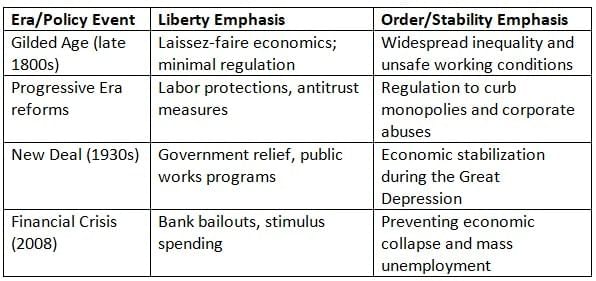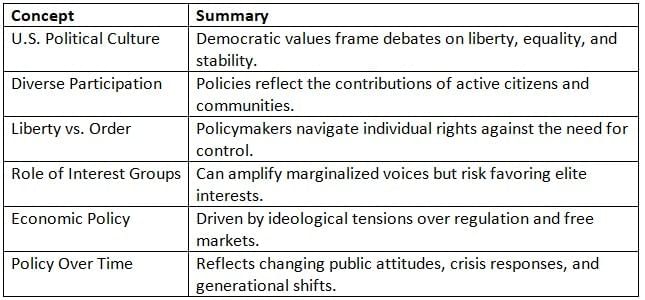Ideology and Policymaking Chapter Notes | Sociology for A Level - Year 13 PDF Download
Introduction
The policymaking process in the United States is influenced by a diverse array of ideological perspectives, democratic principles, and the complexities of a multifaceted society. As a democratic nation, U.S. policies do not stem from a single ideology but are the product of debates, compromises, and the engagement of various individuals and interest groups. Over time, Americans have navigated the challenge of balancing individual liberty with the need for governmental order, resulting in persistent tensions in the legislative process.
Diversity and Participation in Shaping Policy
The United States is characterized by a population with varied racial, ethnic, religious, and socioeconomic backgrounds, each bringing distinct priorities, values, and political objectives to the policymaking arena. When individuals from these diverse communities participate in the political process, they play a crucial role in shaping national policies.
Historically, politically active groups have driven significant policy changes through activism and mobilization:
- Progressive Era (early 1900s): This period saw reforms like the introduction of the federal income tax, child labor protections, and food safety regulations, leading to the establishment of regulatory agencies such as the Food and Drug Administration (FDA).
- Women's Suffrage Movement: The struggle for voting equality culminated in the 19th Amendment, broadening political participation and redirecting policy focus toward issues like women’s health, education, and labor rights.
- Civil Rights Movement: African Americans’ advocacy for racial equality led to landmark legislation, including the Civil Rights Act of 1964 and the Voting Rights Act of 1965, which transformed national policy priorities.
These examples illustrate how the convictions and demands of engaged groups directly impact policy outcomes. However, access to political influence is not evenly distributed.
Key Challenge: Marginalized groups, such as people of color, immigrants, and low-income individuals, often face underrepresentation in government, causing their policy needs to be overlooked at times.
Public opinion and activism are frequently channeled through interest groups, which advocate for specific issues and seek to sway legislators.
- Interest groups can amplify the voices of underrepresented communities, champion environmental causes, or defend civil liberties.
- Conversely, more affluent or entrenched groups may dominate policy discussions, potentially skewing outcomes away from the broader public’s interests.
While interest groups can raise awareness and drive essential reforms, their influence may also concentrate power among a select few, creating imbalances in representation.
The Ongoing Debate: Liberty vs. Order
A fundamental tension in U.S. policymaking revolves around balancing individual liberty with the need for societal stability and order. This dynamic has shifted across different historical periods, influenced by social, political, and economic contexts.
Expanding Liberty Through Policy
Policies that enhance rights and freedoms often arise in response to persistent inequalities or societal pressure. Notable examples include:
- Abolition of Slavery: The 13th Amendment, by outlawing slavery, marked a significant expansion of liberty following the Civil War, driven by moral and political transformations.
- Voting Rights Expansion: Challenges to barriers based on race, gender, and income led to policies ensuring broader electoral access.
- Civil Liberties in Education: The Supreme Court’s ruling in Tinker v. Des Moines (1969) affirmed that students retain First Amendment rights in schools, strengthening protections for free expression.
These cases demonstrate the evolution of political culture toward greater inclusivity over time.
Prioritizing Order and Stability
In contrast, some policies emphasize governmental authority to ensure security or economic stability, often during times of crisis:
- Japanese Internment during World War II: Justified as a national security measure, this policy restricted the freedoms of thousands of innocent Japanese Americans.
- USA PATRIOT Act: Enacted after the 9/11 attacks, this law expanded government surveillance capabilities to combat terrorism, sparking debates over privacy and civil liberties.
- Red Scare: During this period, civil liberties were curtailed to counter perceived communist threats.
These examples underscore how governments have, at times, limited freedoms in response to public demands for safety, order, or national cohesion.
Key Insight: The balance between liberty and order is fluid, shaped by public sentiment, conflict, or socioeconomic instability.
Economic Regulation and Government Intervention
Economic policy is a key arena where ideological conflicts unfold. The U.S. has oscillated between prioritizing free-market principles and implementing regulatory measures, reflecting public priorities and responses to crises.
The New Deal and the 2008 financial crisis responses exemplify government expansion to restore stability during economic turmoil. Critics argue that excessive intervention undermines individual economic freedom, while supporters maintain that such measures are vital for safeguarding the public interest.
Public Opinion and Policy Outcomes
The policies resulting from political debates are shaped by the attitudes and beliefs of engaged citizens at a given time. These perspectives evolve, influenced by generational differences, social movements, and external events.
Examples include:
- In the 1960s, growing public support for civil rights drove Congress to enact landmark anti-discrimination laws.
- In the 1980s, a rising preference for limited government contributed to Ronald Reagan’s election and policies like tax cuts and deregulation.
- More recently, increasing concerns about healthcare access and climate change have influenced national debates, leading to legislation such as the Affordable Care Act.
Policies are deeply tied to the values of those who participate through voting, protesting, donating, or organizing.
Key Takeaways

Understanding the ideological underpinnings of laws clarifies why certain policies gain traction while others falter. American policymaking is not solely a function of institutions but is also shaped by values, identities, and public engagement. The ongoing challenge lies in balancing liberty and order in a way that addresses the needs and principles of a diverse population.
Key Terms
- 19th Amendment: Ratified in 1920, this amendment granted women the right to vote, a landmark achievement of the women’s suffrage movement that expanded political participation and reshaped policy priorities, reflecting shifts in gender equality ideology.
- Affordable Housing Policies: Government initiatives to ensure access to economically viable housing, aimed at preventing homelessness and promoting equity, influencing social welfare and economic stability.
- Agricultural Support Policies: Government programs providing financial aid, price stabilization, and risk management to farmers, ensuring food security and supporting rural economies.
- Anti-Lynching Laws: Legislation aimed at criminalizing lynching at the federal level to protect marginalized groups from racially motivated violence, reflecting ideologies of justice and civil rights.
- Anti-Segregation Legislation: Laws designed to dismantle racial segregation in public spaces and institutions, advancing equality and justice during the civil rights movement.
- Child Labor Laws: Regulations protecting children from exploitative work conditions, ensuring access to education and reflecting evolving societal values on child welfare.
- Civil Liberties Protection in War Times: Legal measures safeguarding individual rights during conflicts, highlighting tensions between national security and personal freedoms.
- Diversity and Policy: The influence of diverse backgrounds and perspectives on policymaking, fostering equitable and inclusive policy solutions.
- Economic Regulation Policies: Government interventions to regulate markets, promote competition, and protect consumers, shaped by ideological views on government’s economic role.
- Eight-Hour Workday: A labor reform advocating for an eight-hour workday to improve workers’ quality of life, reflecting ideologies of fairness and labor rights.
- Federal Income Tax: A progressive tax system funding government operations, influenced by ideological debates over equity and economic efficiency.
- Federal Reserve System: The U.S. central banking system, established in 1913, managing monetary policy and financial stability, impacting economic ideologies and policymaking.
- Financial Crisis Response: Government actions, like bailouts and stimulus, to stabilize economies during crises, shaped by ideologies on government intervention.
- Food and Drug Administration (FDA): A federal agency ensuring the safety of food, drugs, and medical products, influencing health policy through regulatory standards.
- Individual Liberty vs. Stability and Order: The tension between protecting personal freedoms and maintaining societal security, a core debate in policymaking.
- Japanese American Internment: The forced relocation of Japanese Americans during World War II, driven by security concerns but violating civil liberties, reflecting ideological conflicts.
- Natural Resource Preservation Policies: Regulations to conserve natural resources, balancing environmental stewardship with economic needs.
- New Deal Reforms: Franklin D. Roosevelt’s programs during the Great Depression, expanding government’s role in economic relief and recovery, reshaping policy frameworks.
- Patriot Act: Post-9/11 legislation enhancing national security through expanded surveillance, sparking debates over civil liberties and security.
- Progressive Era: A period of reform from the 1890s to 1920s addressing industrialization’s challenges, advancing democracy and social equity.
- Special Interest Groups: Organizations advocating for specific policy goals, influencing legislation but sometimes amplifying elite interests over public needs.
- Voting Rights Expansion: Efforts to broaden voting access for marginalized groups, driven by ideologies of fairness and representation.
- Workplace Safety Standards: Regulations ensuring employee safety, reflecting societal values on worker protection and influencing labor policy.
|
133 docs|13 tests
|
FAQs on Ideology and Policymaking Chapter Notes - Sociology for A Level - Year 13
| 1. What are the different types of polls used to measure public opinion? |  |
| 2. How do researchers choose sampling methods for polls? |  |
| 3. What types of questions are typically used in public opinion polls? |  |
| 4. Why is the format of questions important in polls? |  |
| 5. How is public opinion measured and why is it important? |  |















